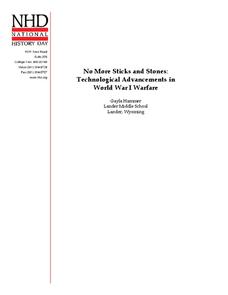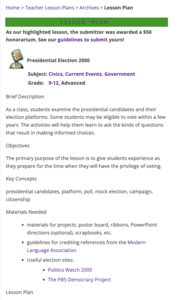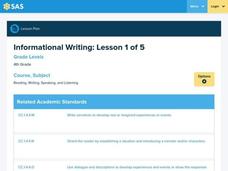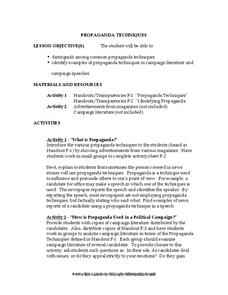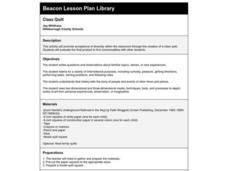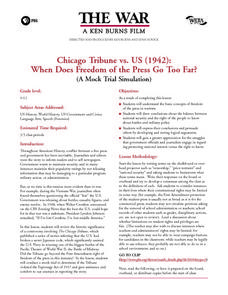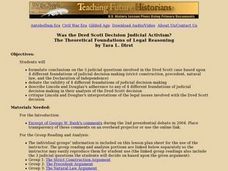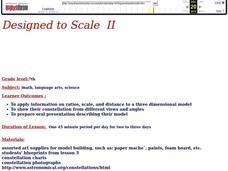Curated OER
Where Am I? Determining Relative Location
Students use position words to describe where their teacher is sitting and read a story that makes use of position words. In this spatial instructional activity, students make a stick puppet and play Simon Says focusing on using position...
Curated OER
Please, Take A Message
High schoolers identiry which information is important to capture when dictating a telephone message. In pairs, students practice dictating and recording telephone messages using a dedicated telephone message pad. This activity is...
Curated OER
Hate 2.0
Combat hate online by bringing it into the light. Begin by giving learners a quiz, then lead a discussion based on the issues the quiz brought up. As a class, develop strategies to confront online hate. Assign different venues to groups...
National History Day
No More Sticks and Stones: Technological Advancements in World War I Warfare
Remind young historians that many technological advancements influenced the events of World War I. After analyzing technology's evolution through primary sources, discussing the changes over time, and watching various video clips,...
Curated OER
Presidential Election 2000
Students examine the presidential candidates and their election platforms. They further analyze the platforms by creating a chart to determine which candidate most represents his or her beliefs and values.
Curated OER
My Secret War: Lesson 5
Fifth graders determine how freedom comes with rights and responsibilities through literature and poetry about World War II. In this World War II lesson, 5th graders use the letters in the word "infamy" to write an acrostic poem. They...
Curated OER
1960 America: Foreign Policy
The 1960's marked shifts in American culture, politics, and policy. Your class groups up to research a series of primary source documents resulting in a timeline and a 15 minute oral presentation. Active learning all the way.
University of California
Principles vs. Practices
Have you ever wondered what your own World Order would look like? Scholars use primary and secondary documents as well as video clips to investigate and analyze the Cold War. Using the sources, the principles and practices of nations...
National Endowment for the Humanities
Kate Chopin's The Awakening: Local Color in the Late 19th Century
Kate Chopin's The Awakening introduces readers not only to the lush Louisiana setting of Grand isle but also to the nuances of Creole culture. the second lesson in a three-part series examines how Chopin's use of literary realism and...
Curated OER
In My Other Life
Students explore various cultural identities. They conduct Internet research, develop a questionnaire that profiles information from their selected culture, and write a letter to a pen pal in the U.S. explaining what life in their...
Curated OER
Civil Liberties and War Powers: Korematsu v. United States
Eleventh graders compare and contrast Supreme Court decisions dealing with the application of civil rights during times of war, with emphasis on discrimination and detention. Working in groups, 11th graders review cases and analyze how...
Pennsylvania Department of Education
Informational Writing
Emerging writers identify an informational piece of writing. They are provided with examples of informational writing and view a PowerPoint on narrative writing. Then, they design their own informational writing with a brochure,...
Curated OER
Writing Skills: Fables
Use fables as a fun way for English Language Learners to gain confidence and fluency in their reading and speaking skills. After reading a fable in class, they retell their story to a group of their peers. When this jigsaw activity is...
Curated OER
Propaganda Techniques
Young scholars recognize and separate various techniques of propaganda. In this propaganda lesson, students read a handout about the various types of propaganda and how it is used ina political campaign.
Curated OER
Carter as President and Ex-President
Students examine how Presidents are judged during their time in office as well as afterwards. They conduct and Internet search for Jimmy Carter's inaugural address and write a news story about his address. Once they have written an...
Curated OER
Class Quilt
First graders engage in a lesson which promote acceptance of diversity within the classroom through the creation of a class quilt. They evaluate the final product to find commonalities with other students.
Curated OER
Sportswriting
Learners complete a variety of activities (using the Washington Post Newspaper) that reinforce concepts involved in sports writing.
Curated OER
Chicago Tribune vs. US (1942): When Does Freedom of the Press Go Too Far?
Students define freedom of the press in peace and war time. As a class, they identify the need for the public to be informed, but discuss where the line should be drawn to protect national security. They develop their arguments and...
Foreign Policy Research Institute
Understanding the Koreas
Though this resource was designed in 2005, US tension with North Korea remains a relevant topic for exploration and understanding. Unfortunately, this lecture and reading-based lesson plan is unlikely to engage the class. The end product...
Curated OER
My Favorite Things
Pupils identify "masterpieces" and mass-produced objects. They explain why they value a given object and determine what physical materials were used to create the objects. They create a class book featuring objects that they value.
Curated OER
Was the Dred Scott Decision Judicial Activism?
Students debate the validity of 4 different foundations of judicial decision-making. They describe Lincoln and Douglas's adherence to any of 4 different foundations of judicial decision-making in their analysis of the Dred Scott decision
Curated OER
Editorial Writing: What's On Your Mind
Students write an editorial column for a newspaper. For this journalism lesson, students discuss and analyze editorials in print and broadcast media. Students will compare the differences in these two formats of editorial pieces and then...
Curated OER
Designed to Scale
Seventh graders construct a three dimensional model of a constellation. In this constellation lesson, 7th graders make a blueprint for a scale model of the constellation and create their models. They present their models to the class.
Curated OER
Designed to Scale
Seventh graders study ratios, scale and distances according to a three dimensional model. In this exploratory lesson students create their own constellation and prepare an oral presentation that describes their model.





